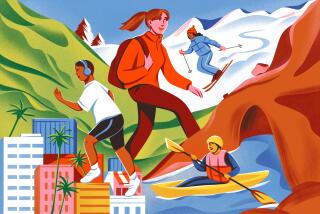Digging up couch potatoes
We now know where the couch potatoes lurk in this country, thanks to a new report from the U.S. Centers for Disease Control and Prevention that tracks our physical activity down to the county level. California, with a climate that invites every sport from surfing to snowboarding, is among the more physically active states, but the CDC’s map shows that exercise is about more than the weather. Minnesotans are more likely to get a move on than we are. Yet practically all of Mississippi is depicted in dark blue on the map, meaning that close to a third or more residents get no leisure-time exercise.
Fully a quarter of all adults in the United States get no exercise outside of work, according to the report, which is based on census figures and surveys of self-reported activity levels. It is the latest in a series of CDC reports analyzing the rise of diabetes in the U.S., and the data are adjusted for age, so that a retiree state doesn’t end up being compared unfairly with others.
Western states tend to be more active; the most sluggish states are concentrated in the South and Appalachia, which also tend to have the highest obesity and diabetes rates. And though that’s not exactly surprising, the maps provide a vivid image of how lifestyle choices are affecting America’s health.
What we don’t yet know is exactly why people are rising from their couches in some corners of the country — and even within each state — and why others aren’t. Yes, weather and to some extent affluence offer more opportunities. But that doesn’t account for why 18% of the adults in San Diego County get no exercise, compared with 12% in Santa Cruz County, the most physically active county in California (and where the local University of California campus would be justified in changing its mascot from the banana slug). Close to 20% of Los Angeles County is inactive, but that’s still lower than the nearly 24% in Kern County.
Now that the CDC has done the quantitative analysis, the nation needs a qualitative parsing of the factors behind these differences. How much are diet and exercise a matter of deeply rooted societal traditions, and to what extent would something as simple as bicycle lanes help? Obviously, people in some regions are practicing habits that dramatically reduce diabetes risk. The CDC maps should be on every doctor’s wall and shown in every public school health class. It doesn’t require wealth or perennial sunshine to improve our national health.
More to Read
A cure for the common opinion
Get thought-provoking perspectives with our weekly newsletter.
You may occasionally receive promotional content from the Los Angeles Times.






